Mauser experimental pistols
August 13 202296
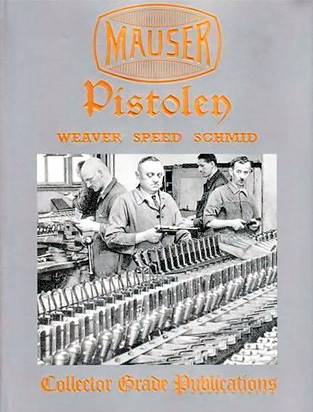
Talking without thinking is like shooting without aiming.
Miguel de Cervantes
First, a small digression. Before the age of the Internet, we had to rely solely on books, magazines, and other printed matter to obtain information, which, before “publishing”, underwent mandatory editorial processing and was evaluated by relevant experts. Today, thanks to the “World Wide Web”, the path from the source of information to its consumer is rapidly shrinking, books, scientific journals, media, archives and documents are becoming easily accessible. But, as always - every medal has a downside - most of the information circulating on the Internet does not pass any examination and is of very dubious quality.
As an example of the above, we can cite an article on the Military Review website “Mauser” of the 1910 model, in which there are a lot of errors, both in the presentation of the sequence of creating structures and in the technical description thereof, as a result of which readers will learn about the “full-size army pistol Mauser” with a movable barrel, “delayed blowback, in which a pair of levers in the frame in front of the trigger guard engaged with the inclined surfaces of the shutter” and with "an unusual shock-absorbing spring at the rear of the frame. Some meticulous reader even complains in the comments that he could not find the scheme of this “mechanism”, which is quite natural, since Mauser never created such a design.
Goal of the game: Destroy as many enemy ships as possible by firing torpedoes an
And what did he create? Let’s try to briefly answer this question.
On August 1, 1896, Paul Mauser demonstrated his C96 pistol to representatives of the rifle department. weapons Gewehr-Prüfungskommission in Spandau. Created in 1877, the “Commission for Testing Rifles” organized military tests of the submitted samples, formulated the conditions for these tests and temporary operating instructions, and evaluated the results. Then the reports were sent to the Ministry of War, which, on the basis of these conclusions, made a decision on whether or not to adopt a particular model.
In addition to representatives of the commission, the demonstration was attended by the War Minister of Württemberg, General Schott-von-Schottenstein, and officers from his ministry. The reviews about the pistol were the most positive, which seemed to inspire optimism about future prospects, however, Paul Mauser decided that it would not be out of place to demonstrate his C96 personally to the German Kaiser Wilhelm II, and sent a corresponding letter to his adjutant Helmut von Moltke on August 10, 1896, and already on August 19 he received an answer that the Kaiser enthusiastically accepted his proposal.
On the course of the presentation that took place on August 20, 1896 in Katarinenholz, as they would say today, we will not dwell in detail, it is described in many articles about C96. 6-, 10- and 20-round pistol samples were presented, as well as a 10-round carbine.

Ten-shot carbine, which was personally fired by Wilhelm II, the last German emperor
Kaiser was very impressed with the pistol, he especially liked the shooting from the model in the carbine version, after which Wilhelm II asked Paul Mauser how long it would take him to create a self-loading rifle. Mauser replied that he would need five years.
And from this very time until his death in 1914, Paul Mauser spent most of his time in the experimental workshop of the firm, known as the Versuchsabteilung (approximate translation - development department or experimental department), abbreviated as V-Abt. V-Abt was led by Fidel Federle, and his brothers Josef and Friedrich also worked there.
Seventeen variants of self-loading rifle mechanisms were developed and patented, but in the end all were unsuccessful and did not go beyond prototypes or small-scale samples. Paul Mauser even lost his left eye in an accident while testing rifles. The pistols created during this period by Gebrüder Mauser bear a clear imprint of this “rifle epic”. Most of the models did not leave the factory, but working on them allowed the company’s engineers to gain the necessary experience.
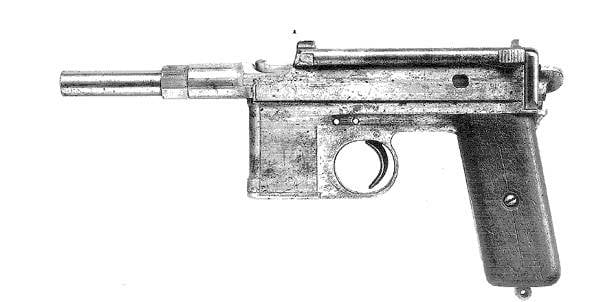
The prototype of the pistol, made presumably in 1898-1900.
The principle of operation is not exactly known, perhaps this is a “by-product” of the creation of a Mauser self-loading rifle with a long barrel stroke. As you know, some prototypes of pistols were created on the basis of the designs of self-loading rifles being developed.
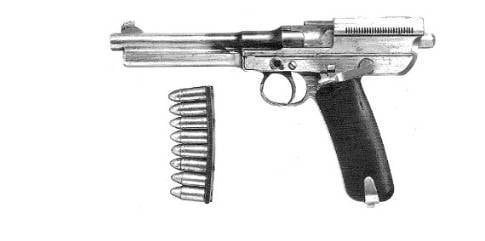
Experimental pistol C02. Automation with a long stroke of the barrel and locking by turning the combat larvae of the shutter. The clip with cartridges in the picture shows all types of ammunition that were used in experienced pistols. The bottom two are experimental 9x19 cartridges from DWM. The first, second, fifth and sixth are experienced 9x21 DWM cartridges. The second and third are also 9x21 DWM, but with a different type of bullet
As is known today, in weapons with a long stroke, the barrel linked to the bolt travels together the full recoil path inside the receiver, while the length of this path is necessarily greater than the full length of the cartridge, and the operations of unlocking and opening, closing and locking the bore are separated in time . Hence, firstly, the low rate of fire, and secondly, the increase in the dimensions of the receiver, and this is excess weight. The area of contact between the lugs of the larva and the supporting surfaces of the receiver should be sufficient to securely lock the bore. This is again the dimensions and weight. The symmetrical arrangement of the lugs requires a very high precision in the manufacture of the parts of the locking unit so that they can work simultaneously, perceiving the pressure of the gases. Among other things, this design contains a large number of parts and is very sensitive to contamination and lubrication.
The next sample was developed in 1906. It was a pistol, designated in the company’s documentation as C06.
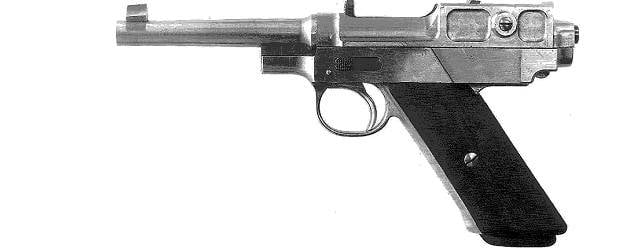
Experienced pistol Mauser C06. First option
For this pistol, an automation system with barrel recoil during its short stroke was chosen. But on the method of locking it is worth stopping a little.
It is designated in the patent as “mit gleitendem Lauf und in dem Vecrschlubriegel schwingbar gelagerteim Vecrschlubriegel”. From the name, which sounds like “a movable barrel with a bolt hinged in the barrel casing,” it is problematic to draw any conclusions about the structure of this very bolt, but the preserved drawings and photographs come to the rescue.
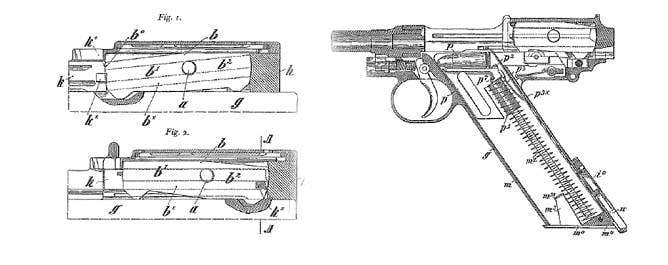
So the locking unit looks like in the drawing
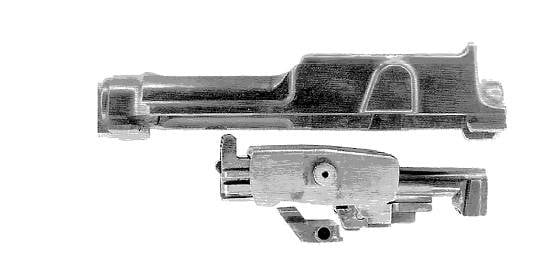
And so in metal. In fact, this is a lever lock, although it is implemented in a rather original way. The shutter is locked by a massive larva rotating on an axis fixed in the receiver, and the rotation is carried out in a vertical plane parallel to the axis of the bore
Several variants of the C06 pistol, which were not fundamentally different, were created, shown in the illustrations below.
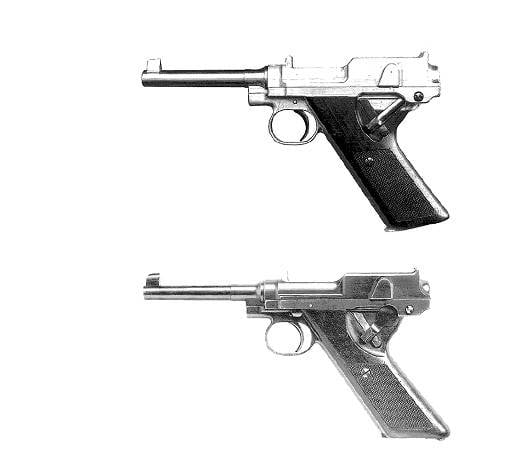
On the next model, 1906, called “Trial Pistol C 06/08”, Paul Mauser for some reason returned to the location of the store, like the C96, in front of the trigger guard; the shop was removable.
All known examples were produced in the rare experimental caliber 9 mm Mauser (9x21 mm), with the exception of serial number 3, which was chambered in 9 mm Mauser Export (9x25 mm). A removable magazine was inserted from below, known samples had a capacity for six, seven, eight or seventeen rounds.
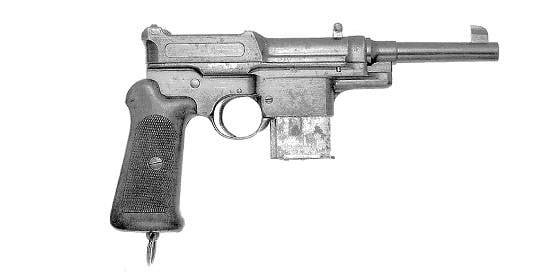
Mauser pistol C06/08, serial number 18
The serial numbers of the surviving copies and photographs indicate that at least 200 pistols were made, that is, quite a lot compared to previous single samples, it is obvious that Mauser intended to submit this model to the German government for official testing. This is also indicated by the fact that the Spandau Arsenal produced in 1907 a special batch of 9x21 mm Mauser cartridges.
Why the Mauser reverted to a forward magazine remains a mystery, especially given the fact that this arrangement was one of the reasons the Kaiserlichmarine preferred the P08 Luger over the C96 Mauser after testing ended in 1903.
The Trial Pistol C 06/08 pistol automation drive is the recoil energy of the barrel during a short stroke, as in previous samples, but the locking mechanism is a semi-free shutter, based on the design of the shutter of a self-loading rifle MODEL 06-08, MAUSER SEMI-AUTOMATIC RIFLE .
As you know, the semi-free is the shutter of small arms, which encounters resistance when moving backward due to the connection with the receiver. The design of semi-free gates can be the most diverse with the use of cam, lever, lever-cam mechanisms.
In the C06/08 pistol, the lever mechanism, that is, the locking at the moment of firing the shutter, is carried out by two symmetrically located lugs, made in the form of levers, hinged in the receiver.
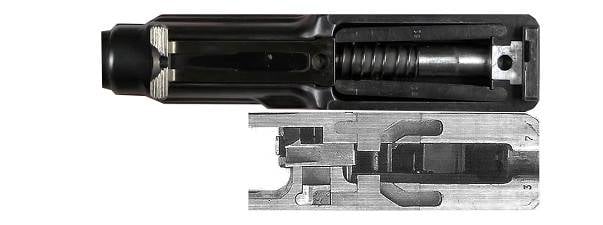
In the picture: at the top - the bolt before the shot, the lugs (parts marked “51”) are brought together, the bolt is locked; below - the frame of the pistol with the receiver removed. Symmetrical curly grooves are clearly visible
At the time of the shot, the barrel with the receiver moves back under the influence of recoil, the leading cams located on the lower plane of the lugs interact with the side surfaces of the curly grooves of the pistol frame, which achieves the breeding of the lugs, the bolt is unlocked and then moves freely.

The shutter is in the rearmost position after the shot, the lugs are divorced. The shop feeder is clearly visible
Mauser himself believed that the developed design was very simple and reliable, but tests showed a result that was clearly the opposite of what was expected, the pistol turned out to be extremely unsuccessful. It was not possible to achieve stable, without delay, work in the “pistol version” from the mechanism designed for the rifle. Among other things, the gun turned out to be overweight, more than a kilogram of weight, poorly balanced.
It is clear that this pistol had no chance of being put into service, but today it is highly appreciated by collectors. Prices for some copies reach 60 USD.
Having received another “damn lumpy”, Mauser takes an inexplicable step - he creates a “hybrid” of their two pistols - C06 and C06 / 08. From the first they took a handle with a magazine and a trigger mechanism. From the second - a barrel with a receiver and a bolt.
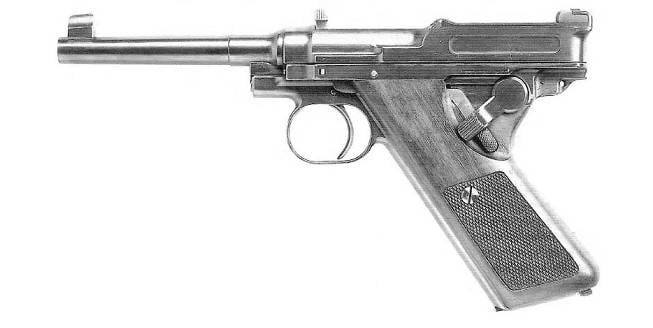
Pistol «C06 – C06/08» Hybrid
Why did Mauser decide that two unsuccessful designs would make one successful one, story is silent. The only copy was made, which did not even receive a serial number.
It would seem that such a long series of failures could turn Mauser away from the “pistol theme”, especially since the company’s rifles by that time were widely used not only in Germany, but were also exported to the states of Europe, the Middle East, Asia, Africa, Latin America , USA and Canada, and the company’s hunting weapons in the world market enjoyed a very high reputation. That is, the company did not experience a shortage of orders.
But Paul Mauser was not only a talented designer, but also a talented entrepreneur, therefore, as they say, he “felt the future”. In addition to the rapidly expanding market for police and civilian pistols, in Europe, the creation of the Entente finally ended the delimitation of the great powers and clearly smelled of a big war. It was impossible to miss this opportunity, and work on the creation of pistols at Gebrüder Mauser und Cie is being further developed.
Paul Mauser and Fidel Federle put forward the idea of creating a universal design, on the basis of which it would be possible to produce pistols for various purposes with minimal changes - from pocket pistols, caliber 6,35 mm for the civilian market, to models chambered for 9 mm, for the army. It was at this time that the young talented engineer Josef Nickl was involved in the work of V-Abt, who began working for the company in 1904, who played a significant role in creating the “pistol” family.
A model chambered for 9×19mm Parabellum with a fixed barrel and automatics was chosen as the base model, the operation of which was based on the principle of recoil of a free shutter. Mauser quite logically concluded that it was necessary to move from a more powerful cartridge to a less powerful one. Judging by the patent drawings, the work began in 1907.
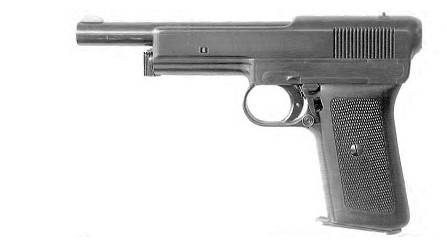
The first prototype of the Mauser Model 1909 pistol with a long barrel chambered for 9x19mm Parabellum. A square hole on the housing-shutter - the place of attachment of the spring buffer
And from the very first prototypes, it became clear that the powerful 9×19mm Parabellum cartridge and the free breech for a pistol were far from being the optimal combination. Strong recoil required an increase in the mass of the casing-bolt and the rigidity of the return spring, but then the weight and size characteristics of the weapon clearly went beyond the acceptable limits. As an alternative measure, a spring buffer was placed in front of the shutter casing, which was supposed to take on some of the recoil energy.
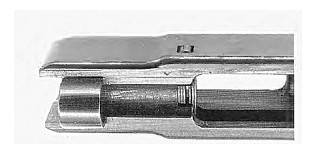
Spring buffer pistol Mauser Model 1909. Structurally, it is a Belleville spring, consisting of several interconnected disks (“plates”). Belleville springs are used to dampen shocks where it is necessary to create high forces in limited dimensions.
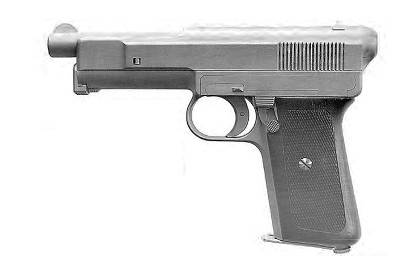
The second prototype of the Mauser Model 1909 pistol with a short barrel chambered for 9 × 19 mm Parabellum
But the buffer did not help to solve the problem. Then Mauser takes the next step - he develops a new cartridge, the dimensions of which remain the same as those of 9 × 19 mm Parabellum, but the weight of gunpowder is significantly reduced. In this way, the return was reduced to an acceptable level, but the meaning of creating the structure was clearly lost. A small number of Mauser Model 1909 pistols were nevertheless made. Several copies are in private collections. The cost is from 50 000 USD.
Thus, Mauser was convinced that the development of a blowback pistol chambered for 9 × 19 mm Parabellum had no prospects, and work was stopped. But time and money were not spent in vain, since the Mauser Model 1909 pistol, as expected, served as the basis for the very successful Mauser Model 1910, Mauser 1910/14, Mauser 1914, Mauser 1910/34, Mauser 1914/34 under less powerful cartridges 6,35 Browning and 7,65 Browning. The above models were produced in total for more than thirty years - from 1910 to 1941.
What about Paul Mauser? Oh, he is again, for the umpteenth time, attempting to create a pistol chambered for 9 × 19 mm Parabellum! Moreover, the task becomes more complicated, since it also provides for the creation of a variant chambered for .45 ACP!
The new design, created on the basis of the experimental Mauser Model 1909 and the serial Mauser Model 1910, had a fixed barrel and automation, the operation of which was based on the principle of semi-free recoil. Recall that the task of a semi-free shutter is, without a significant increase in the mass of the moving system, to slow down the unlocking of the barrel due to the connection with the receiver or frame to such an extent that by the end of the gas aftereffect period the sleeve does not move out of the chamber by a significant amount and at the same time the moving system acquires enough inertia to do the work of reloading the weapon.
Mauser created an original knot for this purpose - Stutzklappe. Translation of German technical documentation is sometimes a non-trivial task, even with the use of special thematic dictionaries. In this case, the closest translation is “spring-loaded retarding block”. In the future, this term will be used together with the original name.
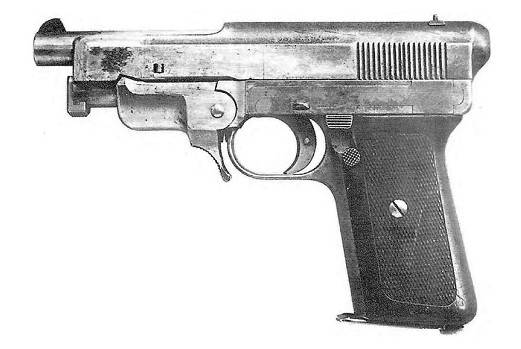
The first prototype of a pistol chambered for 9×19 mm Parabellum. The Stutzklappe mounted on the transverse axis and the lever to unlock it in front of the trigger guard are clearly visible. The presence of a square hole in the front of the shutter housing indicates that the design, like the Mauser Model 1909, uses a spring buffer
The retarding block is essentially a lever (larva) swinging in a vertical plane, located in front of the trigger guard, the supporting surfaces of which were included in the corresponding curly grooves of the casing-gate. After the shot, the shutter, in order to start moving, must overcome the resistance of the block by turning it counterclockwise around the transverse axis. The configuration of the bearing surfaces of the block and the shutter casing was calculated in such a way as to ensure that the shutter slows down for a time sufficient for the bullet to leave the barrel. In order to take the shutter to the rearmost position manually, without much effort, a special lever is provided to unlock it.
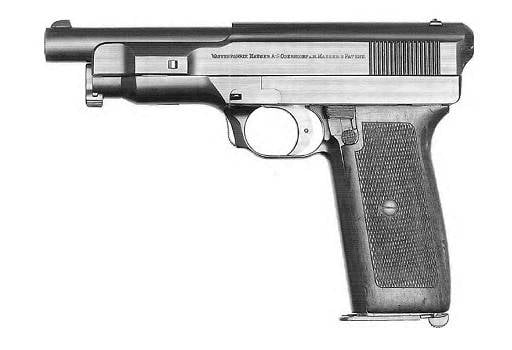
One of the first prototypes of pistols chambered for .45ACP. The bulky external structure was abandoned, the Stutzklappe was placed inside the frame, the release lever passes through a special lug groove on the front of the trigger guard. This design still has a spring buffer
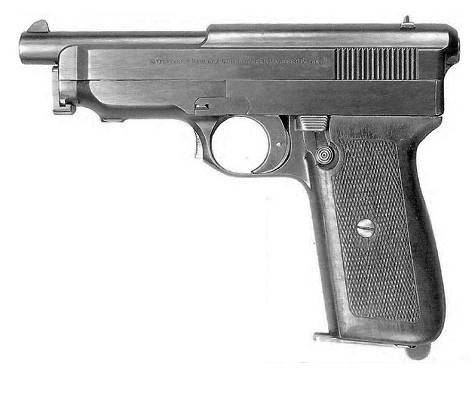
Prototype pistol chambered for 9×19 mm Parabellum. The design in general and the locking mechanism in particular is similar to the pistol chambered for .45ACP, but there is no spring buffer
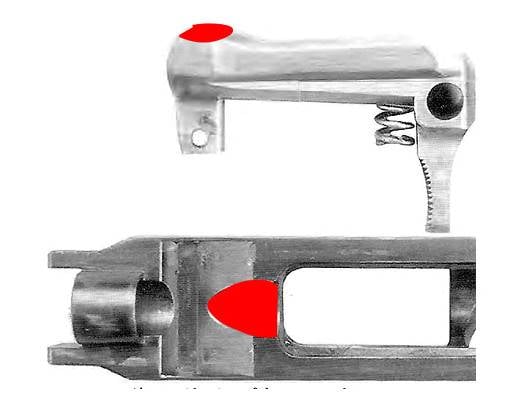
In the picture: at the top - a slowing down block, at the bottom - a bottom view of the shutter. As is clear from the image, in order to start moving, the bolt must overcome the spring force of the retarding block, “drowning” it into the groove of the pistol frame. The stiffness of the spring provided slowing down the shutter for a time sufficient for the bullet to leave the barrel. The red color shows the supporting surfaces that interacted with the shutter and the slowing block

In the picture: at the top - the frame of the pistol with the bolt cover removed. The groove for installing the retarding block is clearly visible; below - a frame of a pistol with a retarding block installed
At first glance, the design of the slowing block is simple and reliable, but in practice the node had a very limited resource, so its design was changed again.
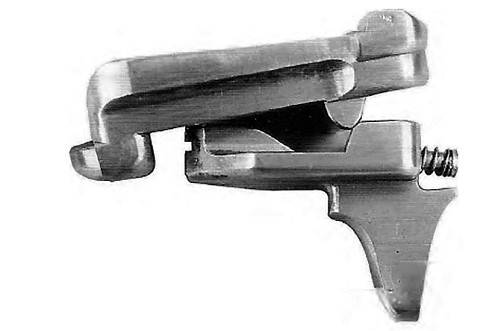
Third variant of the Stutzklappe
The general principle of operation has not changed, but now the decelerating unit consisted of two parts that worked in series, which, according to the designers, should have more evenly distributed the loads on the structure and increased reliability. The shape of the supporting surfaces has also been changed. But this did not fundamentally resolve the issue.
Therefore, Mauser again, as in the case of the Mauser Model 1909 pistol, returns to the idea of using a cartridge with a lower weight of gunpowder. Such cartridges were produced by DWM. Whether they were used and in what quantity - there is no information. The archive preserved the factory documentation, which shows the comparative characteristics of the Mauser Model 1912 pistol with other pistols produced at that time. It lists the 9×19 mm Parabellum cartridge as ammunition.
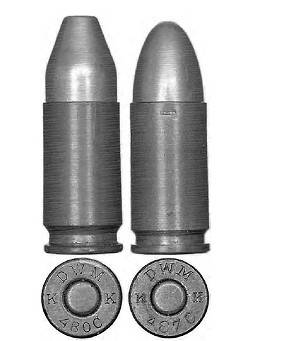
In the picture: on the left - cartridge 9 × 19 mm Parabellum, on the right - cartridge 9 × 19 mm Mauser
At this stage, the pistol receives the designation Mauser Model 1912, and its mass production begins.
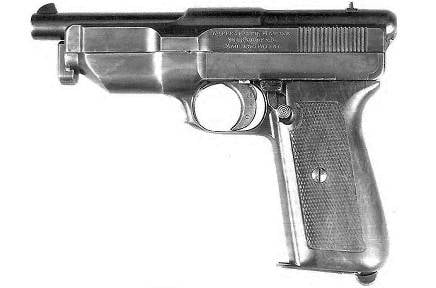
Mauser Model 1912 pistol, serial number 13, with the “rocking” retardation block design described above. In the literature, pistols of this design are called the “first option”. It is easy to identify by the characteristic protrusions on the side surfaces of the shutter casing and the frame above the front of the trigger guard.
However, the production of the “first version” ended, almost without starting, since less than a hundred copies were made. The design of the slow shutter assembly has been changed again. Instead of a lever swinging in a vertical plane, the deceleration was carried out by two lugs moving in a horizontal plane, similar to the design of the Trial Pistol C 06/08 pistol.
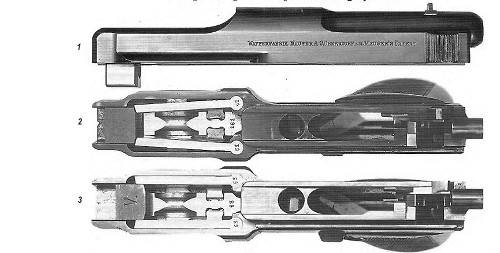
In the photo:
1 - housing-bolt of the Model 1912 pistol. A protrusion interacting with the lugs is visible from the front below;
2 - the position of the parts before the shot, the lugs are brought together;
3 - the position of the parts after the shot and the bullet leaving the barrel, the protrusion of the shutter-casing overcame the resistance of the spring, the lugs are divorced
As can be seen from the above snapshot, the principle of operation of the deceleration unit is as follows. After a shot, the bolt, in order to start moving, must overcome the resistance of the lugs, spreading them in a horizontal plane. The configuration of the support surfaces of the stops, the protrusion of the casing-bolt and the spring stiffness of the stops is designed in such a way as to ensure that the shutter slows down for a time sufficient for the bullet to leave the barrel. In order to take the shutter to the rearmost position manually, without much effort, a special lever is provided to unlock it.
This is where the changes in the design of the Mauser Model 1912 pistol end and its mass production resumes.
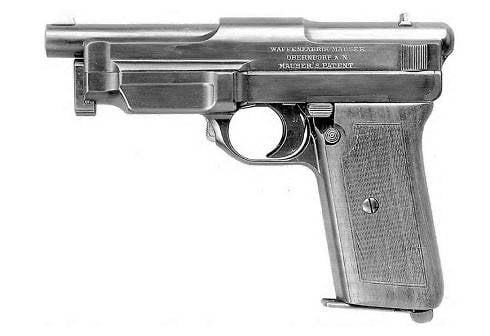
Pistol Mauser Model 1912. Caliber - 9 mm. The ammunition used is 9×19 mm Parabellum. Magazine capacity - 9 rounds. Weight with equipped magazine - 980 grams. The initial speed of the bullet is 340 m / s. Overall dimensions - 182x140x32 mm. The pistol has a fixed barrel and automatics, the operation of which is based on the principle of recoil of a semi-free shutter
The exact number of manufactured Mauser Model 1912 pistols has not yet been established. The literature usually indicates “a few hundred”, and this is with the modification Model 1914/1912 that appeared in early 1914. This modification had guides on the handle and was completed with a holster-butt.
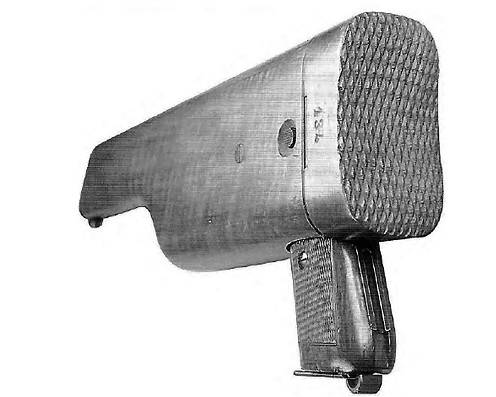
Some of the pistols had an adjustable sight with divisions from 50 to 500 meters. They were designated Model 1912/1914 Armeepistole.
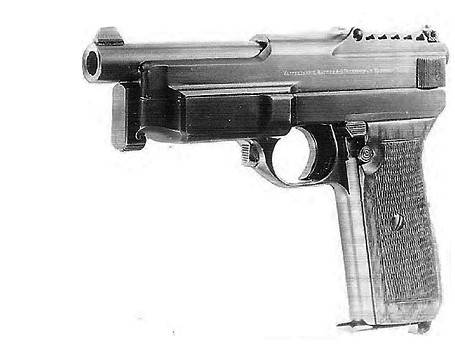
Several prototypes chambered for .45ACP were also made. According to the device, they are identical to pistols chambered for 9 mm
Potential consumers of both the Model 1912 and Model 1912/1914 pistols were, let’s say, extremely cool. In 1913, a small batch for testing was ordered by the Brazilian Navy. Some interest was shown by commercial structures in the same Brazil, Mexico, the USA, Russia and Germany itself, ordering trial lots.
But in 1914, two events happened that, in fact, put an end to the gun. On May 29, Peter Paul von Mauser died. And two months later, on July 28, the First World War began. The Mauser-Werke plant in Oberndorf switched to fulfilling army orders. The pistols in stock were sent to the front. The few surviving examples today are the subject of collectors’ desires.
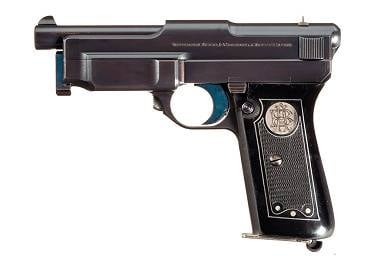
This Model 1912/1914 pistol was sold in 2016 for $97
Использованная литература:
Weaver W. Darrin, Jon Speed, Walter Schmid. Mauser Pistolen: Development and Production, 1877–1948. Collector Grade Publications.
Smith WHB Mauser Rifles and Pistols. The Stackpole Company. Harrisburg, Pennsylvania.
Kirillov V. M. Foundations for the device and design of small arms.
Blagonravov A. A. Grounds for the design of automatic weapons.